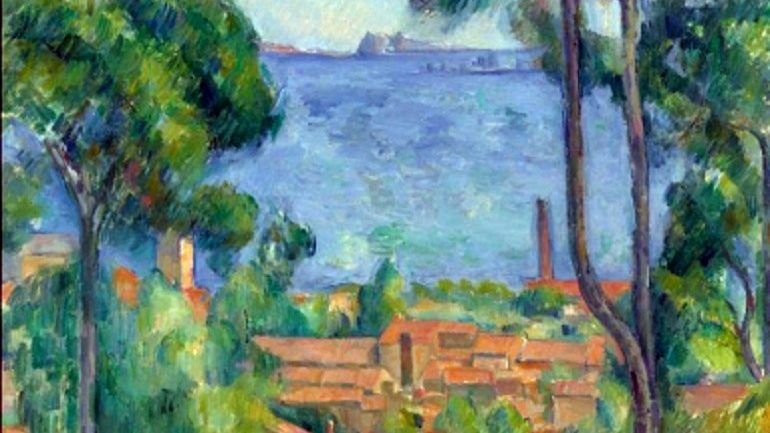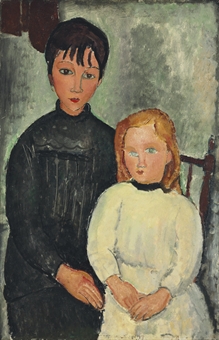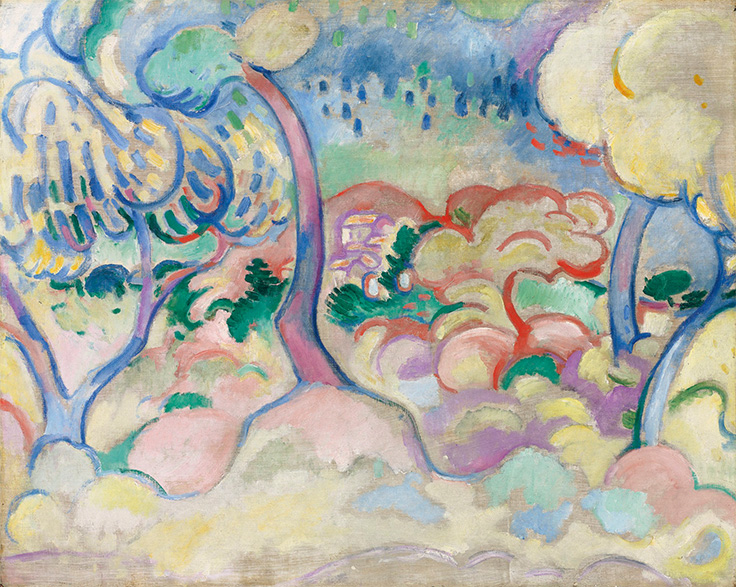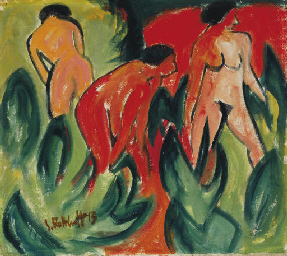A broad array of jewel-like, museum quality works with exceptional provenance, many of which are coming to the market for the first time in several generations, lead Christie’s Impressionist and Modern Art Evening Sale in London on 4 February 2015. Epitomising the creative dynamism, developments and influential legacy of the leading artists in the category, the sale presents a total of 44 works led by Vue sur L’Estaque et Le Château d’If, circa 1883-1885, by Paul Cézanne, a masterpiece which is coming to the market for the first time since it was acquired in 1936 by Samuel Courtauld, the founder of the illustrious Courtauld Gallery and Institute of Art in London.
Christie’s announced the sale of a masterpiece by Paul Cézanne, Vue sur L’Estaque et Le Château d’If, which comes to the market for the first time since it was acquired in 1936 by Samuel Courtauld, the founder of the illustrious Courtauld Gallery and Institute of Art in London (estimate: £8-12 million). The painting remained in Courtauld’s private collection throughout his lifetime and following his generous bequest to the Courtauld Gallery. One of the leading highlights of the Impressionist & Modern Art Evening Sale on 4 February 2015, this magisterial work was painted circa 1883-1885, during one of the last visits that Cézanne ever made to L’Estaque, a fishing port and small seaside resort in his native Provence, where he sought inspiration repeatedly from the mid-1860s. This is a rare example on a vertical canvas of Cézanne’s treatment of this iconic motif; the format lends the composition stately dignity and remarkable concentration of colour and form.
The splendid panorama – captured in Vue sur L’Estaque et Le Château d’If - from the hilltop above the town, looking over the rooftops toward the bay of Marseille and the distant islands of Frioul, provided the basis for some of the most innovative landscapes of Cézanne’s career, in which he fully realised his goal to “make of Impressionism something solid and enduring like the art in museums.”
The stable and harmonious distribution of forms within the composition, with broad horizontal bands of land, sea, and sky framed by majestic pine trees, is profoundly indebted to the classical landscape tradition of Poussin, which Cézanne used to organise his sensations before nature. At the same time, Cézanne’s constructive transformation of the townscape into an architectural geometry of flat, overlapping planes is powerfully modern, as the next generation of the avant-garde would recognise. “The discovery of his work overturned everything,” exclaimed Braque, who traveled to L’Estaque repeatedly during the formative years of cubism.
More on Cézanne and L’Estaque
Amedeo Modigliani
Les deux filles
More on Cézanne and L’Estaque
Amedeo Modigliani
Les deux filles
Les deux filles is a rare double portrait by Amedeo Modigliani (1884-1920)
which is offered at auction for only the second time having previously been in
the same family collection for over 90 years (estimate: £6-8 million, illustrated left).
One of only five recognised double portraits by Modigliani, this beautiful
painting is preserved in its original unlined condition. This sale provides the
market with a rare opportunity as three of the other four double portraits are in
major public collections; The Art Institute of Chicago, The Centres Georges
Pompidou, Paris, and The National Gallery of Art, Washington D.C.. Modigliani
used his portraits to provide a visual window into the soul. The present example,
which portrays two girls sitting side by side, highlights the contrast of age and
life experience of the two sitters. The elder girl also appears in an individual
portrait by the artist now in the Kunstmuseum Basel. Les deux filles was first
acquired by Leopold Zborowski, the artist’s dealer, who had financed
Modigliani’s lifestyle and paid for his materials in return for all his paintings since 1916. Before 1923 it was acquired by Jonas Netter, one of the greatest collectors of the artist’s work during his lifetime, later passing by descent until it was acquired by the present owner at Christie’s London in 2009.
Modigliani’s lifestyle and paid for his materials in return for all his paintings since 1916. Before 1923 it was acquired by Jonas Netter, one of the greatest collectors of the artist’s work during his lifetime, later passing by descent until it was acquired by the present owner at Christie’s London in 2009.
Juan Gris
La Lampe
Painted in May-June 1914, La Lampe by Juan Gris belongs to a series of collages considered to be among the artist’s greatest contributions to Cubism, establishing Gris as a leading innovator of the revolutionary movement and placing him alongside Picasso and Braque (estimate: £2.5-3.5 million, illustrated left). The property of a private collector and unseen in public for over 30 years, since it was exhibited at the seminal Cubism show held at the Tate in London in 1983, it is an exquisite example of the artist’s mastery of papier collé, one of the Cubist’s favoured artistic techniques in which layers of found paper are arranged across the surface. Displaying a masterful inventiveness and a refined subtlety, La Lampe has been hailed by the Cubist scholar and collector Douglas Cooper as “an exceptionally fine example of what Gris could achieve in papier collé”. This work presents collectors and institutions with a very rare opportunity, as the majority of Gris’ 1914 collages now reside in major museums around the world, such as The Metropolitan Museum of Art, New York; The Museum of Modern Art, New York; The Philadelphia Museum of Art; and The Rijksmuseum Kröller-Müller, Otterlo, a testament to their unparalleled quality and important position within the development of Cubism. Christie’s set a new benchmark for the artist in February 2014 when Nature morte à la nappe à carreaux, 1915, sold for £34,802,500, setting a world record price for the artist at auction.
Georges Braque
Paysage à L’Estaque
At auction for the first time in over half a century, Paysage à L’Estaque, painted in 1907, by Georges Braque is one of the artist’s early landscapes of Provence (estimate: £2-3 million. The Property of a Distinguished Private Collection, this work was painted in the midst of one of the most experimental and formative years in Braque’s career, at a time when his Fauvist style was becoming increasingly more structured. Paysage à L’Estaque was included in the historic exhibition held in 1908 at the Galerie Kahnweiler, highlighting the importance of the period in which it was painted.
Die Brücke
Highlighting the industrial chemist Dr Carl Hagemann’s role as one of the most important patrons, supporters and collectors of Die Brücke, is a fine and remarkably fresh group of four works from his collection which were acquired in the 1920s, representing three of the four founding artists of the
movement - Erich Heckel, Ernst Ludwig Kirchner and Karl Schmidt- Rottluff. Die Brücke, formed in Dresden in 1905, aimed to explore fresh new styles of artistic expression centred on colour and form; advocating a return to nature, the group moved away from the constraints of the traditional academic style.
Badende am Waldteich by Erich Heckel is one of the masterpieces of Die Brücke art (estimate: £1.5-2 million, ). It was painted during the joyous and ground-breaking summer of 1910 when Heckel, Kirchner and Pechstein lived and worked together on the lakes of Moritzburg. A dynamic, spontaneous and swiftly executed depiction of the Brücke group and their companions cavorting together amidst the fields, trees and sun-filled shoreline of Moritzburg, Badende am Waldteich is one of a pulsating series of pictures that were made during this last and consummate summer that the three artists spent together. More than any other Brücke group paintings, it is their Moritzburg pictures of nudes living free in the landscape that best encapsulate their collective ideal and shared aesthetic. Representing the pinnacle of the Brücke’s achievement, Badende am Waldteich is one of the finest surviving examples of all the paintings Heckel made during this seminal period.
Painted in May-June 1914, La Lampe by Juan Gris belongs to a series of collages considered to be among the artist’s greatest contributions to Cubism, establishing Gris as a leading innovator of the revolutionary movement and placing him alongside Picasso and Braque (estimate: £2.5-3.5 million, illustrated left). The property of a private collector and unseen in public for over 30 years, since it was exhibited at the seminal Cubism show held at the Tate in London in 1983, it is an exquisite example of the artist’s mastery of papier collé, one of the Cubist’s favoured artistic techniques in which layers of found paper are arranged across the surface. Displaying a masterful inventiveness and a refined subtlety, La Lampe has been hailed by the Cubist scholar and collector Douglas Cooper as “an exceptionally fine example of what Gris could achieve in papier collé”. This work presents collectors and institutions with a very rare opportunity, as the majority of Gris’ 1914 collages now reside in major museums around the world, such as The Metropolitan Museum of Art, New York; The Museum of Modern Art, New York; The Philadelphia Museum of Art; and The Rijksmuseum Kröller-Müller, Otterlo, a testament to their unparalleled quality and important position within the development of Cubism. Christie’s set a new benchmark for the artist in February 2014 when Nature morte à la nappe à carreaux, 1915, sold for £34,802,500, setting a world record price for the artist at auction.
Georges Braque
Paysage à L’Estaque
At auction for the first time in over half a century, Paysage à L’Estaque, painted in 1907, by Georges Braque is one of the artist’s early landscapes of Provence (estimate: £2-3 million. The Property of a Distinguished Private Collection, this work was painted in the midst of one of the most experimental and formative years in Braque’s career, at a time when his Fauvist style was becoming increasingly more structured. Paysage à L’Estaque was included in the historic exhibition held in 1908 at the Galerie Kahnweiler, highlighting the importance of the period in which it was painted.
Die Brücke
Highlighting the industrial chemist Dr Carl Hagemann’s role as one of the most important patrons, supporters and collectors of Die Brücke, is a fine and remarkably fresh group of four works from his collection which were acquired in the 1920s, representing three of the four founding artists of the
movement - Erich Heckel, Ernst Ludwig Kirchner and Karl Schmidt- Rottluff. Die Brücke, formed in Dresden in 1905, aimed to explore fresh new styles of artistic expression centred on colour and form; advocating a return to nature, the group moved away from the constraints of the traditional academic style.
Badende am Waldteich by Erich Heckel is one of the masterpieces of Die Brücke art (estimate: £1.5-2 million, ). It was painted during the joyous and ground-breaking summer of 1910 when Heckel, Kirchner and Pechstein lived and worked together on the lakes of Moritzburg. A dynamic, spontaneous and swiftly executed depiction of the Brücke group and their companions cavorting together amidst the fields, trees and sun-filled shoreline of Moritzburg, Badende am Waldteich is one of a pulsating series of pictures that were made during this last and consummate summer that the three artists spent together. More than any other Brücke group paintings, it is their Moritzburg pictures of nudes living free in the landscape that best encapsulate their collective ideal and shared aesthetic. Representing the pinnacle of the Brücke’s achievement, Badende am Waldteich is one of the finest surviving examples of all the paintings Heckel made during this seminal period.
Acquired directly from the artist in 1928, Badende am Meer/ Die Schlittenfahrt is a
double-sided canvas sporting two very different images from two highly
important moments in Ernst Ludwig Kirchner’s career - his summer visits to
the isle of Fehmarn between 1912 and 1914 and the genesis of the
new direction in his art that began in the Swiss Alps in the early 1920s (estimate: £1-1.5 million). Painted in 1913 and between 1922 and 1926
respectively, the recto depicts bathers on the Fehmarn coastline, and on the verso, a winter sleigh ride in the
mountains near Davos in Switzerland to where
Kirchner moved in 1919 to recuperate from the psychological trauma of the Great War. Spanning the years that were to have such
a defining impact on the style and manner of the artist’s work, this double-sided
picture illustrates the dramatic change in Kirchner’s work, through two very
different images from two of the most influential and important locations and
times in the artist’s career.
Badende am Strand by Karl Schmidt-Rottluff is one of the finest and most mature of Schmidt-Rotluff’s paintings on his favourite and most enduring subject: nude bathers at the beach (estimate: £1-1.5 million, illustrated left). An outstanding example of the dramatic, mature Expressionist style that the artist developed in the early 1920s, Badende am Strand has been on permanent loan to the Germanisches Nationalmuseum in Nuremberg for the last 34 years. Painted in 1922, Badende am Strand derives from one of the most important periods in Schmidt-Rotluff’s career when the artist was consciously forging a freer, more intense and optimistic form of Expressionist painting in the immediate aftermath of the First World War. One of the most radical and near abstract of all Schmidt-Rottluff’s paintings, Badende am Strand is a work that not only represents a culmination in the direction his painting took after the War but also stands as one of the most interesting and significant of all his art works.
Badende am Strand by Karl Schmidt-Rottluff is one of the finest and most mature of Schmidt-Rotluff’s paintings on his favourite and most enduring subject: nude bathers at the beach (estimate: £1-1.5 million, illustrated left). An outstanding example of the dramatic, mature Expressionist style that the artist developed in the early 1920s, Badende am Strand has been on permanent loan to the Germanisches Nationalmuseum in Nuremberg for the last 34 years. Painted in 1922, Badende am Strand derives from one of the most important periods in Schmidt-Rotluff’s career when the artist was consciously forging a freer, more intense and optimistic form of Expressionist painting in the immediate aftermath of the First World War. One of the most radical and near abstract of all Schmidt-Rottluff’s paintings, Badende am Strand is a work that not only represents a culmination in the direction his painting took after the War but also stands as one of the most interesting and significant of all his art works.




